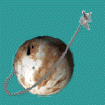
Current Issues:
SpaceViews
SpaceViews Update
Breaking News
Back Issues
Search
Subscriptions
Submissions
Forum
Space Sites of the Week
Home
Mars Pathfinder
Comet Hale-Bopp
Top Ten Stories of '96
Life on Mars?
Pathfinder Mission Moves Into Monitoring Phase
Nearly two months after landing on the surface of Mars, the Mars Pathfinder spacecraft is moving into what project scientists called a "monitoring" phase, with an emphasis on atmospheric data and rover operations.
![[image of rover on Mars]](../9709/images2/sojourner.jpg) Both the rover and lander are operating well, project scientist Matthew Golombek reported at a press conference August 27. The vehicles have spent more than 50 days on the surface, far exceeding the one-month primary mission for the lander and one-week mission for the rover.
Both the rover and lander are operating well, project scientist Matthew Golombek reported at a press conference August 27. The vehicles have spent more than 50 days on the surface, far exceeding the one-month primary mission for the lander and one-week mission for the rover.
Golombek reported the Sojourner rover had overcome some problems it encountered while driving through a dense area of rocks known as the "Rock Garden." Sojourner had become stuck between two rocks and ended up driving over another as it made its way to its destination, a smooth, dust-free rock dubbed Shark.
The rover was delayed by several days during its journey, but survived undamaged. Mission controllers were directing Sojourner to several other rocks in the area over the next week.
With most of the main imaging projects for the mission, including the high-resolution "super pan", completed, the mission's emphasis will shift to long-term atmospheric monitoring as the climate in the landing site shifts from summer to winter.
Recent atmospheric observations show the conditions there have remained stable, with high temperatures around -10 degrees Celsius (15 degrees Fahrenheit) and lows around -75 Celsius (-103 Fahrenheit). The number of dust devils seen by Pathfinder has increased, though, with at least a dozen observed in the last three weeks.
Pathfinder also imaged a high-altitude cloud of water ice one morning in the pre-dawn hours. Data taken during the descent of Pathfinder to the surface also suggests the spacecraft passed through a thin cloud of carbon dioxide ice about 80 km above the surface.
![[image of Golombek]](../9709/images2/golombek.jpg) Planetary scientists have also found that the rocks around the landing site appear to be in one of two broad classes. One class, which includes the rocks Barnacle Bill and Shark, have high concentrations of silica, while the other class has elevated amounts of sulfur. The cause for these compositional differences is unclear.
Planetary scientists have also found that the rocks around the landing site appear to be in one of two broad classes. One class, which includes the rocks Barnacle Bill and Shark, have high concentrations of silica, while the other class has elevated amounts of sulfur. The cause for these compositional differences is unclear.
Golombek also confirmed plans to send Sojourner to the peak of a nearby hill, after completing a reconnaissance around the lander and checking the composition of dust that has collected on magnets mounted to the side of the lander.
Golombek said he believes both the lander and rover can continue to operate for up to a year. "I don't want another job for at least a year," he said.
